by Ana Wang, Graduate Student at The Scripps Research Institute
With St. Patrick’s Day around the corner and a tumultuous start to 2017, most of us probably hope for a little of that fabled Luck o’ the Irish, and what’s more hopeful this time of year than finding a four-leaf clover? The myth of the four-leaf clover bringing good fortune has cultural origins that may be as simple as the fact that these clovers are rare, so finding one can make you feel special – or lucky. And they are pretty uncommon – on average, you’d have to search through 10,000 clovers to find one four-leaf clover! More rare still are clovers with five, six, seven, or more leaves – but they do exist. Currently, the world record is at 56 leaves on a clover found in Japan!
Four-leaf clover
Have you ever wondered why some clovers have four (or more) leaves? Or maybe you’ve wondered why more clovers don’t have four leaves. Well, look no further as we are going to delve into the science behind this lucky charm.
Whether or not a clover has the fortuitous fourth leaf – (or, more accurately leaflet) – is largely based on the code in the clover’s genetic material. That being said, the exact cause of the fourth leaflet is hard to study and largely unknown, due to some quirks of the clover’s DNA. The common clover in North America is the white clover* which has four copies of each gene.** For reference, humans and most other organisms only have two copies of each gene. To add to the white clover’s genetic complexity, each chromosome (which contains the genes) in an individual clover often comes from a different species. You can imagine how hard it is to study lineage and inheritance with essentially four different parents!
Five-leaf clover
It is hypothesized that many genes, rather than a single gene, contribute to the determination of whether a clover is a trifoliate (three leaflets) or multifoliate (more than three leaflets). The Parrott Lab at the University of Georgia shed some light on this issue by studying three-leaf and four-or-more-leaf clovers in separate, but identical, surroundings. This set-up allowed the researchers to zero in on differences that stemmed from only genetics, as it kept the environmental influences of the two groups the same. Studying the DNA from the clovers showed that the multifoliate trait is recessive to the trifoliate trait. This means that even when a clover contains genes for both traits, it will have a trifoliate morphology. This is predominantly why the multifoliate variants are much more rare than the traditional three-leaf shamrock.
Genes are not the end of the four-leaf-clover story, however. The Parrott Lab also did some work on environmental influences. They ran their studies in both summer and winter and found more four-leaf clovers grew in the summertime, showing that genes AND the environment influence the number of leaves on a clover. Many suspect that chemicals and radiation may also increase the occurrence of four-or-more leaf clovers – but that has yet to be proven.
Three-leaf shamrock
The four-leaf clover has become an international symbol of good luck. It is said that St. Patrick used the shamrock – the clover symbol of Ireland - to explain the Holy Trinity, with each leaflet representing one hypostasis . It is also said that the three leaflets represent hope, faith, and love. To many today, the fourth leaflet on a four-leaf-clover represents luck. To many in the Middle Ages, it was believed to bestow the carrier with the magical power to see fairies. To plant biologists, though, it can represent the amazing complexity and infinite possibilities that lie within even a seemingly simple and common weed.
*The scientific name for the white clover is Trifolium repens, where trifolium refers to three leaves.
**Organisms with four copies of each gene are called allotetrapoloids.
References:
· “Most Leaves on a clover.” Guinness World Records. Web. 15 March, 2017.
· Tashiro, Rebecca M., et al. Leaf Trait Coloration in White Clover and Molecular Mapping of the Red Midrib and Leaflet Number Traits. Crop Science 50, 1260-1268 (2010).
Images:
Many clovers: By JPS68via Wikimedia Commons
Four-leaf clover: By Calignano via Wikimedia Commons
Five-leaf clover: By 本人 - 本人, via Wikimedia Commons
Three-leaf Shamrock: via Wikimedia Commons





